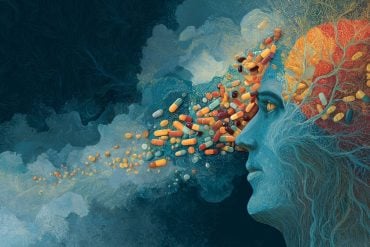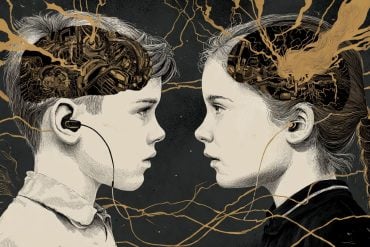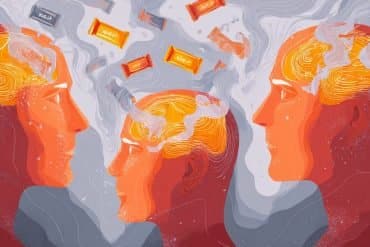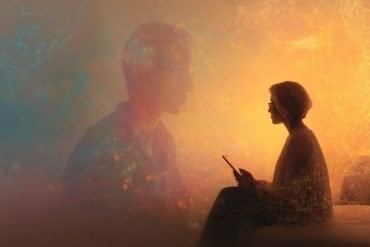Summary: Fruit flies exposed to blue light had significantly reduced longevity than those exposed to natural light or kept in darkness. Exposure to blue light for 12 hours a day accelerated aging phenotypes, causing retinal damage, neurodegeneration, and impaired locomotion.
Source: Oregon State University
Prolonged exposure to blue light, such as that which emanates from your phone, computer, and household fixtures, could be affecting your longevity, even if it’s not shining in your eyes.
New research at Oregon State University suggests that the blue wavelengths produced by light-emitting diodes damage cells in the brain as well as retinas.
The study, published today in Aging and Mechanisms of Disease, involved a widely used organism, Drosophila melanogaster, the common fruit fly, an important model organism because of the cellular and developmental mechanisms it shares with other animals and humans.
Jaga Giebultowicz, a researcher in the OSU College of Science who studies biological clocks, led a research collaboration that examined how flies responded to daily 12-hour exposures to blue LED light – similar to the prevalent blue wavelength in devices like phones and tablets – and found that the light accelerated aging.
Flies subjected to daily cycles of 12 hours in light and 12 hours in darkness had shorter lives compared to flies kept in total darkness or those kept in light with the blue wavelengths filtered out. The flies exposed to blue light showed damage to their retinal cells and brain neurons and had impaired locomotion – the flies’ ability to climb the walls of their enclosures, a common behavior, was diminished.
Some of the flies in the experiment were mutants that do not develop eyes, and even those eyeless flies displayed brain damage and locomotion impairments, suggesting flies didn’t have to see the light to be harmed by it.
“The fact that the light was accelerating aging in the flies was very surprising to us at first,” said Giebultowicz, a professor of integrative biology. “We’d measured expression of some genes in old flies, and found that stress-response, protective genes were expressed if flies were kept in light. We hypothesized that light was regulating those genes. Then we started asking, what is it in the light that is harmful to them, and we looked at the spectrum of light. It was very clear cut that although light without blue slightly shortened their lifespan, just blue light alone shortened their lifespan very dramatically.”
Natural light, Giebultowicz notes, is crucial for the body’s circadian rhythm – the 24-hour cycle of physiological processes such as brain wave activity, hormone production and cell regeneration that are important factors in feeding and sleeping patterns.
“But there is evidence suggesting that increased exposure to artificial light is a risk factor for sleep and circadian disorders,” she said. “And with the prevalent use of LED lighting and device displays, humans are subjected to increasing amounts of light in the blue spectrum since commonly used LEDs emit a high fraction of blue light. But this technology, LED lighting, even in most developed countries, has not been used long enough to know its effects across the human lifespan.”
Giebultowicz says that the flies, if given a choice, avoid blue light.
“We’re going to test if the same signaling that causes them to escape blue light is involved in longevity,” she said.
Eileen Chow, faculty research assistant in Giebultowicz’s lab and co-first author of the study, notes that advances in technology and medicine could work together to address the damaging effects of light if this research eventually proves applicable to humans.

“Human lifespan has increased dramatically over the past century as we’ve found ways to treat diseases, and at the same time we have been spending more and more time with artificial light,” she said. “As science looks for ways to help people be healthier as they live longer, designing a healthier spectrum of light might be a possibility, not just in terms of sleeping better but in terms of overall health.”
In the meantime, there are a few things people can do to help themselves that don’t involve sitting for hours in darkness, the researchers say. Eyeglasses with amber lenses will filter out the blue light and protect your retinas. And phones, laptops and other devices can be set to block blue emissions.
“In the future, there may be phones that auto-adjust their display based on the length of usage the phone perceives,” said lead author Trevor Nash, a 2019 OSU Honors College graduate who was a first-year undergraduate when the research began. “That kind of phone might be difficult to make, but it would probably have a big impact on health.”
Source:
Oregon State University
Media Contacts:
Jaga Giebultowicz – Oregon State University
Image Source:
The image is in the public domain.
Original Research: Open access
“Daily blue-light exposure shortens lifespan and causes brain neurodegeneration in Drosophila”. Trevor R. Nash, Eileen S. Chow, Alexander D. Law, Samuel D. Fu, Elzbieta Fuszara, Aleksandra Bilska, Piotr Bebas, Doris Kretzschmar & Jadwiga M. Giebultowiczy.
npj Aging and Mechanisms of Disease doi:10.1038/s41514-019-0038-6.
Abstract
Daily blue-light exposure shortens lifespan and causes brain neurodegeneration in Drosophila
Light is necessary for life, but prolonged exposure to artificial light is a matter of increasing health concern. Humans are exposed to increased amounts of light in the blue spectrum produced by light-emitting diodes (LEDs), which can interfere with normal sleep cycles. The LED technologies are relatively new; therefore, the long-term effects of exposure to blue light across the lifespan are not understood. We investigated the effects of light in the model organism, Drosophila melanogaster, and determined that flies maintained in daily cycles of 12-h blue LED and 12-h darkness had significantly reduced longevity compared with flies maintained in constant darkness or in white light with blue wavelengths blocked. Exposure of adult flies to 12 h of blue light per day accelerated aging phenotypes causing damage to retinal cells, brain neurodegeneration, and impaired locomotion. We report that brain damage and locomotor impairments do not depend on the degeneration in the retina, as these phenotypes were evident under blue light in flies with genetically ablated eyes. Blue light induces expression of stress-responsive genes in old flies but not in young, suggesting that cumulative light exposure acts as a stressor during aging. We also determined that several known blue-light-sensitive proteins are not acting in pathways mediating detrimental light effects. Our study reveals the unexpected effects of blue light on fly brain and establishes Drosophila as a model in which to investigate long-term effects of blue light at the cellular and organismal level.






